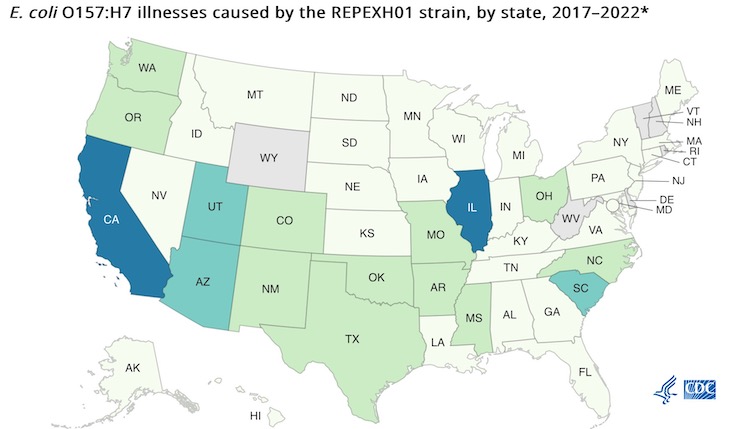The CDC says that there is a persistent strain of E. coli O157:H7 in the United States that has caused illnesses and outbreaks. Illnesses caused by this strain, REPEXH01, occur year round but are less common in the winter. This strain has sickened people through contaminated food and contaminated recreational water.

Persistent is a term used by the CDC to describe strains that have caused illnesses for years. Even though the number of illnesses may change over time, they continue to cause sickness. And these strains are sometimes linked to more than one course, making them more difficult to control.
The strain is “relatively” diverse genetically, within 21 allele differences of one another. That is more diverse than pathogens that cause typical multistep foodborne illnesses outbreaks, when bacteria are generally within 1 allele differences of each other.
The number of people sickened by this strain by state from 2017 to 2021 is: Alabama (3), Alaska (8), Arizona (25), Arkansas (12), California (249), Colorado (10), Connecticut (3), District of Columbia (1), Florida (1), Georgia (5), Hawaii (9), Idaho (5), Illinois (43), Indiana (6), Iowa (1), Kansas (1), Kentucky (2), Louisiana (9), Maine (2), Maryland (7), Massachusetts (2), Michigan (2), Minnesota (9), Mississippi (10), Missouri (16), Montana (3), Nebraska (3), Nevada (3), New Jersey (2), New Mexico (12), New York (3), North Carolina (14), North Dakota (3), Ohio (18), Oklahoma (11), Oregon (11), Pennsylvania (7), South Carolina (27), South Dakota (2), Tennessee (3), Texas (19), Utah (20), Virginia (9), Washington (16), and Wisconsin (7). The outbreak date range is estimated, based on reported or estimated illness onset dates.
Thie strain was first detected in April 2o17. Fourteen outbreaks are attributed to this strain, and there are five identified outbreak sources. Thec confirmed outbreaks include a recreational water outbreak and an outbreak linked to romaine lettuce. Suspected outbreaks include an outbreak linked to leafy greens, and two linked to ground beef.
The confirmed romaine lettuce outbreak occurred in 2018. There were 238 people sickened in 37 states. Ninety-six people were hospitalized, and 27 patients developed hemolytic uremic syndrome (HUS), a type of kidney failure. Five people died. The lettuce was harvested in Arizona. The outbreak strain was found in canal water taken from the Yuma, Arizona growing region. That canal, and several romaine farms, was close to a Concentrated Animal Feeding Operation (CAFO), which held 100,000 cattle at any one time.
The other outbreaks by this stain included a mystery E. coli O157:H7 outbreak that may have been associated with ground beef that sickened 12 people in four states in 2018. A mystery leafy greens outbreak in 2018 sickened 25 people in 10 states. In 2019, another suspected unsolved ground beef E. coli O157:H7 outbreak sickened 44 people in 12 states. And in 2021, an unsolved E. coli outbreak sickened 22 people in 11 states and killed one person.
The strain has two major genetic subclusters. Each of those subclusters has caused at least two outbreaks linked to different sources and geographical regions. The greatest number of isolates, 24, is from the Arizona outbreak likely linked to romaine lettuce, and the source was agricultural irrigation water.




